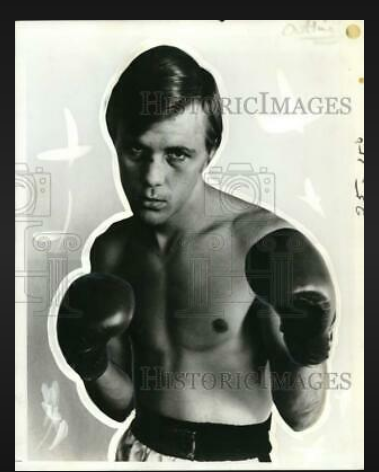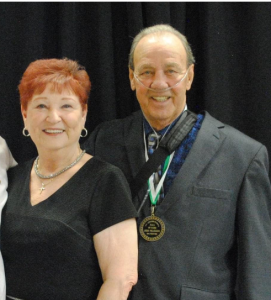Featured Articles
R.I.P. Jerry Pellegrini, Last Vestige of a Golden Era of Boxing in New Orleans

R.I.P. Jerry Pellegrini, Last Vestige of a Golden Era of Boxing in New Orleans
The showdown that the boxing world is most anxious to see, Errol Spence Jr. vs. Terence “Bud” Crawford for the fully unified dominion over the 147-pound weight class, remains stuck in bickering hell, with no signed contracts. That dream bout is an updated version of the better-late-than-never (maybe) pairing of superstar welterweights Floyd Mayweather Jr. and Manny Pacquiao in 2015, which most now can agree would have been more competitive and consequential had it occurred five years earlier.
In boxing, as in life, timing is everything.
But sometimes what the far-flung global masses want, or think they want, is best illustrated when restricted to a particular city and a particular moment, with little more than neighborhood bragging rights at stake. As author Thomas Hauser once said of the rubber match pitting Muhammad Ali and Joe Frazier in the “Thrilla in Manila,” so much more was at stake for the heavyweight legends than the championship of the whole wide world. Ali and Frazier, he noted, were fighting for an even grander prize — the championship of each other.
One of the most important time-and-place fighters of my adolescence and young adulthood, former welterweight contender Jerry “The Boxing Barber” Pellegrini, was 78 when he passed away on July 12 in the New Orleans suburb of Chalmette, La. Although his wife of nearly 60 years, Helen, told me she had not seen a death certificate listing her husband’s cause of death, she believes it was from complications of pulmonary fibrosis, which for several years had slowly been draining Jerry of his former vitality.
Millions of fight fans mourned when Ali, 74, finally was outpointed on June 3, 2016, by the opponent against whom we all are destined to lose. It was much the same when Smokin’ Joe, 67, threw a last left hook at that unconquerable foe and he, too, took his eternal 10-count on Nov. 7, 2011. But while it can be presumed that far fewer followers of the sweet science will take note of the earthly exit of a fighter of more modest accomplishment, Jerry Pellegrini leaves behind not only Helen, but four children, eight grandchildren, three great grandchildren (with another one coming) and a diminishing number of devotees who still fondly remember what he had been as a must-see attraction on New Orleans’ semi-bustling fight scene of the mid-to-late 1960s. I was one of those fans of the “Boxing Barber,” whose big overhand right always seemed more potent than his modest 28-12-1 record, with 12 knockouts, might now suggest.
As a native New Orleanian and the son of a onetime welterweight who once appeared in the main lead-in bout of a card headlined by the great Archie Moore, I was drawn to boxing as a child, watching the Gillette Cavalcade of Sports Friday night fights with my father. And when flickering, black-and-white images on our old Philco TV set proved insufficient to satisfy my boxing jones, Dad took me to amateur shows at St. Mary’s Italian Gym in the French Quarter, where the venerable Whitey Esneault tutored, among others, future world champions Willie Pastrano and Ralph Dupas before turning them over to Angelo Dundee. Other building blocks in my boxing education came at the Municipal Auditorium, where I could study the starkly contrasting styles of welterweight main-eventers Pellegrini. who would rise to a No. 3 world ranking, and Percy Pugh, a shifty technician who made it all the way to No. 1, only to be denied a shot at then-champion Curtis Cokes.
New Orleans, which once had been a hotbed of boxing, had lost at least some of its allure as a pugilistic destination in the ‘60s, so much so that Waddell Summers, then the boxing writer for The Times-Picayune, wrote that “When Whitey Esneault died (at the age of 76, on Jan. 20, 1968), the Golden Age of boxing in New Orleans was laid to rest in St. Roch No. 2 Cemetery.”
But Mr. Summers was a bit premature in shoveling dirt on the fight game’s grave in the Crescent City. New Orleans fighters who would go on to fight for world titles included light heavyweight Jerry Celestine, lightweight Melvin Paul and super lightweight John “Super D” Duplessis, and another native, Regis “Rougarou” Duplessis, would win the WBA and IBF super lightweight belts, along with the WBC Diamond 140-pound crown, although he and his family had relocated to Houston in escaping Hurricane Katrina, so perhaps the city of his birth can only partially claim dibs on his accomplishments.
It was Pellegrini and Pugh, however, who regularly filled the 5,000-seat Municipal Auditorium in those unenlightened times, with black fans sitting on one side of the ring and white fans on the other. It was inevitable that the two would square off, which they did twice, Pugh winning a close 10-round unanimous decision on Sept. 21, 1967 (my 20th birthday) and then lifting Pellegrini’s Southern welterweight title on a 15-round UD on March 3, 1968.
“The first fight should have been called a draw, but the second one he outscored me after 15 rounds,” Pellegrini told me for a story I authored in 2014. “Percy was a good fighter. He was No. 1 in the world.
“But you know, Percy had white supporters and I had black supporters. I think people rooted for me because I got a lot of knockouts and they rooted for Percy because of the way he could move. But we both filled up the auditorium.”
Pellegrini (pictured below in a recent photo with his wife Helen) was paid a career-high $8,700 for the Pugh rematch, which wouldn’t even qualify as pocket money to someone like Mayweather, and even that got thinned by what went to his trainer and manager, not to mention the tax man.

“That was a lot of money back then,” said local promoter Les Bonano. “But imagine if those guys were fighting today. A fight like that might have wound up in the Superdome or New Orleans Arena (now Smoothie King Center) and televised by HBO or Showtime.”
Unfortunately for both Pellegrini and Pugh, neither the Superdome nor the Smoothie King Center existed then. Neither, for that matter, did HBO or Showtime. And the window of opportunity for both fighters – who had come to respect one another professionally and like one another personally – would soon close.
Pellegrini would go just 9-7 after the Pugh rematch. He might have soldiered on, but his power hand, his right, was worsened to a point where an operation might soon have been necessary, a prospect that the barber side of him was disinclined to risk.
“I stopped fighting in 1971 because I had busted my hand all up,” he told me in 2014. “The doctor wanted to operate on it, but I was a barber by trade and I didn’t want nobody cutting on my hand. I might not be able to use my shears or a straight razor. So I retired.
“But 10 years in that ring … I thank God I came out in pretty good shape. Not everybody does. They stay too long because they can’t let it go.”
Pugh – whom I once described as “maybe the best pure boxer to come out of New Orleans” – couldn’t let it go. His blinding hand and foot speed incrementally diminished, he lost his last 10 bouts and 13 of his last 16 to finish with a 47-30 record and just five wins inside the distance. My arguments to get him elected to the Greater New Orleans Sports Hall of Fame unfortunately have fallen on deaf ears, members of the selection committee who never saw him box looking only at that less-than-impressive record, paucity of knockouts and concluding that his numbers just didn’t qualify for a plaque to be hung in the Caesars Superdome.
“Tat-tat-tat, that’s how fast I was,” Pugh, a product of New Orleans’ impoverished Lower Ninth Ward, told John Reid of the Times-Picayune for a story that appeared in 2000. “I could bounce, move and stick my punches. A lot of people didn’t see them coming.”
They say bad things come in threes, and maybe they do. Percy Pugh was 81 when he passed away on Jan. 20 of this year, and Les Bonano, who did make the GNOSHOF cut in 2021 after swimming against the current for a half-century, was 79 when he took his departure from this this mortal coil on May 22, also this year. Now Jerry Pellegrini, whose own boxing journey so notably intersected with those of Pugh and Bonano, also is gone.
Perhaps Waddell Summers’ pronouncement of 54 years ago, premature then, applies now: “When Jerry Pellegrini died, at 78, on July 12, 2022, following Percy Pugh and Les Bonano, the Golden Age of boxing in New Orleans was laid to rest.”
One of the best things about going onto the boxing beat at the Philadelphia Daily News was to become immersed in the city’s rich boxing history and heritage. How could one city have four of the world’s top 10 middleweights at the same time? That I wasn’t there for the glorious primes of Bennie Briscoe, Eugene “Cyclone” Hart, Bobby “Boogaloo” Watts and Willie “The Worm” Monroe is something I will always regret. If I had a time machine to transport me back to that golden – no, diamond – era, I’d visit it often.
Not being so fortunate, I had to satisfy myself for being there when Jerry Pellegrini and Percy Pugh did their down-home replication of such welterweight extravaganzas as Leonard-Hearns I, Trinidad-De La Hoya and Mayweather-Pacquiao. History might not long remember Pugh-Pellegrini, but I was there and it was enough to make an indelible mark in that part of my mind that has been cordoned off for favorite boxing memories.
RIP, Jerry. Thank you for being my friend, and for providing me with some of the incentive to go the distance.
Bernard Fernandez, named to the International Boxing Hall of Fame in the Observer category with the Class of 2020, was the recipient of numerous awards for writing excellence during his 28-year career as a sports writer for the Philadelphia Daily News. Fernandez’s first book, “Championship Rounds,” a compendium of previously published material, was released in May of last year. The sequel, “Championship Rounds, Round 2,” with a foreword by Jim Lampley, is currently out. The anthology can be ordered through Amazon.com and other book-selling websites and outlets.
To comment on this story in the Fight Forum CLICK HERE
-

 Featured Articles4 weeks ago
Featured Articles4 weeks agoAvila Perspective, Chap. 330: Matchroom in New York plus the Latest on Canelo-Crawford
-

 Featured Articles3 weeks ago
Featured Articles3 weeks agoVito Mielnicki Jr Whitewashes Kamil Gardzielik Before the Home Folks in Newark
-

 Featured Articles12 hours ago
Featured Articles12 hours agoResults and Recaps from New York Where Taylor Edged Serrano Once Again
-

 Featured Articles4 weeks ago
Featured Articles4 weeks agoCatching Up with Clay Moyle Who Talks About His Massive Collection of Boxing Books
-

 Featured Articles5 days ago
Featured Articles5 days agoFrom a Sympathetic Figure to a Pariah: The Travails of Julio Cesar Chavez Jr
-

 Featured Articles3 weeks ago
Featured Articles3 weeks agoMore Medals for Hawaii’s Patricio Family at the USA Boxing Summer Festival
-

 Featured Articles7 days ago
Featured Articles7 days agoCatterall vs Eubank Ends Prematurely; Catterall Wins a Technical Decision
-

 Featured Articles4 weeks ago
Featured Articles4 weeks agoRichardson Hitchins Batters and Stops George Kambosos at Madison Square Garden




















